Tomčala Jozef

ÚĽUV master
ÚĽUV master
Tomčala Jozef
Craft
blacksmithing
Material
metal
Place of work
Lehnice (okres Dunajská Streda), Trnava region
More about the producer
As a child, he used to play in the yard with his brother with his father's blacksmith tools. He also enjoyed modeling and constantly whittling wood, so when he applied for an apprenticeship in carpentry after finishing primary school, it was not surprising. However, he was accepted for artistic craftsmanship in metal processing with a focus on blacksmithing and locksmithing,...
Show more
Products approved by the Commission
Products approved for further expansion under the ÚĽUV trademark are documented and preserved in ÚĽUV funds.
Are you interested in the author's products?

Original author's products sold under the ÚĽUV brand. The products mostly come from a smaller workshop with limited production capacity. We ship products that are currently available within 5-14 days of receiving the order. If you are interested in a larger quantity of products than our current stock, we will be happy to discuss the delivery date with you individually. Selected products can only be picked up in person in our stores


















